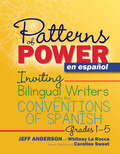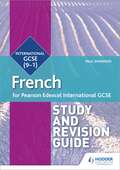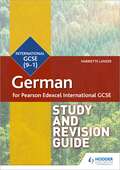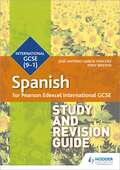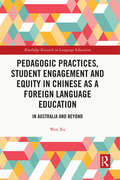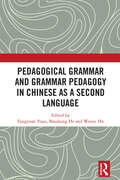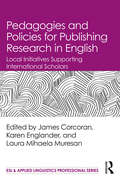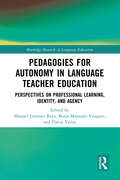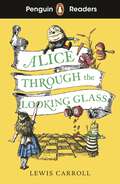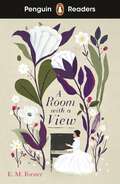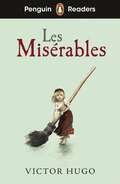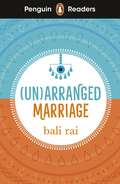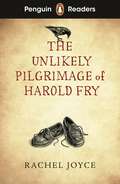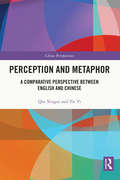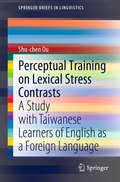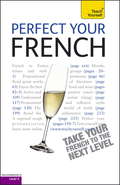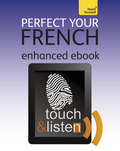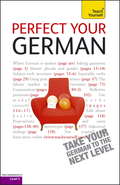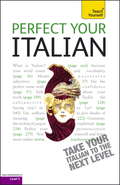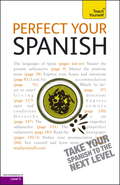- Table View
- List View
Patterns of Power en español, Grades 1-5: Inviting Bilingual Writers into the Conventions of Spanish (Patterns of Power)
by Jeff Anderson Whitney La Rocca Caroline SweetAuthor Jeff Anderson and bilingual teacher and coach Caroline Sweet lead a vibrant approach to grammar instruction in Patterns of Power en español, Grades 1-5: Inviting Bilingual Writers into the Conventions of Spanish. Here, young, emergent writers are invited to notice the conventions of the Spanish language and build off them in this inquiry-based approach to instructional grammar. The book comes with standards-aligned lessons that can be incorporated in just 10 minutes a day. Patterns of Power’s responsive, invitational approach puts students in an involved role and has them explore and discuss the purpose and meaning of what they read. Students study short, authentic texts and are asked to share their findings out loud, engaging in rich conversations to make meaning. Inside you’ll find: Ready-to-use lesson plan sets that include excerpts from authentic and diverse Spanish mentor texts curated for grades 1-5 and can be adapted over 5 grade levels Real-life classroom examples, tips, and Power Notes gleaned from the authors’ experiences that can be applied to any level of writer Resources, including a Patterns of Power Planning Guide adapted for Spanish, to use in classroom instruction or as handouts for student literacy notebooks How to correlate to Spanish TEKS, Common Core, and other state standards Patterns of Power en español, Grades 1-5 provides a simple classroom routine that is structured in length and approach, but provides teachers flexibility in choosing the texts, allowing for numerous, diverse voices in the classroom. The practice helps students build cognitive recognition and provides a formative assessment for teachers on student progress. With these short lessons, students will gain confidence and move beyond limitation to produce effortless writing in your class and beyond. The Patterns of Power series also includes Patterns of Power, Grades 6-8: Inviting Adolescent Writers into the Conventions of Language; Patterns of Power, Grades 1-5: Inviting Young Writers into the Conventions of Language; Patterns of Power, Grades 9-12: Teaching Grammar Through Reading and Writing; and Patterns of Wonder, Grades PreK-1: Inviting Emergent Writers to Play with the Conventions of Language.
Pearson Edexcel International GCSE French Study and Revision Guide
by Paul ShannonSend students into their exam with the confidence to aim for their best with this formula for effective and structured revision including guidance that helps students practice vocabulary, grammar and all four skills.- Enable students to avoid misconceptions with common mistakes highlighted throughout- Build students' vocabulary and grammar knowledge with recaps for each topic- Develop students' reading, listening, speaking and writing skills through short questions for every topic- Allow students to identify areas for improvement with sample answers and commentary for exam-style questions throughout- Prepare students for the exam with extra exam-style questions to try at the back, plus revision tips throughout- Allow students to mark their own responses using the answers in the back of the book
Pearson Edexcel International GCSE French Study and Revision Guide
by Paul ShannonSend students into their exam with the confidence to aim for their best with this formula for effective and structured revision including guidance that helps students practice vocabulary, grammar and all four skills.- Enable students to avoid misconceptions with common mistakes highlighted throughout- Build students' vocabulary and grammar knowledge with recaps for each topic- Develop students' reading, listening, speaking and writing skills through short questions for every topic- Allow students to identify areas for improvement with sample answers and commentary for exam-style questions throughout- Prepare students for the exam with extra exam-style questions to try at the back, plus revision tips throughout- Allow students to mark their own responses using the answers in the back of the book
Pearson Edexcel International GCSE German Study and Revision Guide
by Harriette LanzerSend students into their exam with the confidence to aim for their best with this formula for effective and structured revision including guidance that helps students practice vocabulary, grammar and all four skills.- Enable students to avoid misconceptions with common mistakes highlighted throughout- Build students' vocabulary and grammar knowledge with recaps for each topic- Develop students' reading, listening, speaking and writing skills through short questions for every topic- Allow students to identify areas for improvement with sample answers and commentary for exam-style questions throughout- Prepare students for the exam with extra exam-style questions to try at the back, plus revision tips throughout- Allow students to mark their own responses using the answers in the back of the book
Pearson Edexcel International GCSE German Study and Revision Guide
by Harriette LanzerSend students into their exam with the confidence to aim for their best with this formula for effective and structured revision including guidance that helps students practice vocabulary, grammar and all four skills.- Enable students to avoid misconceptions with common mistakes highlighted throughout- Build students' vocabulary and grammar knowledge with recaps for each topic- Develop students' reading, listening, speaking and writing skills through short questions for every topic- Allow students to identify areas for improvement with sample answers and commentary for exam-style questions throughout- Prepare students for the exam with extra exam-style questions to try at the back, plus revision tips throughout- Allow students to mark their own responses using the answers in the back of the book
Pearson Edexcel International GCSE Spanish Study and Revision Guide
by Tony Weston José Antonio SánchezSend students into their exam with the confidence to aim for their best with this formula for effective and structured revision including guidance that helps students practice vocabulary, grammar and all four skills.- Enable students to avoid misconceptions with common mistakes highlighted throughout- Build students' vocabulary and grammar knowledge with recaps for each topic- Develop students' reading, listening, speaking and writing skills through short questions for every topic- Allow students to identify areas for improvement with sample answers and commentary for exam-style questions throughout- Prepare students for the exam with extra exam-style questions to try at the back, plus revision tips throughout- Allow students to mark their own responses using the answers in the back of the book
Pearson Edexcel International GCSE Spanish Study and Revision Guide
by Tony Weston José Antonio SánchezSend students into their exam with the confidence to aim for their best with this formula for effective and structured revision including guidance that helps students practice vocabulary, grammar and all four skills.- Enable students to avoid misconceptions with common mistakes highlighted throughout- Build students' vocabulary and grammar knowledge with recaps for each topic- Develop students' reading, listening, speaking and writing skills through short questions for every topic- Allow students to identify areas for improvement with sample answers and commentary for exam-style questions throughout- Prepare students for the exam with extra exam-style questions to try at the back, plus revision tips throughout- Allow students to mark their own responses using the answers in the back of the book
Pedagogic Practices, Student Engagement and Equity in Chinese as a Foreign Language Education: In Australia and Beyond (Routledge Research in Language Education)
by Wen XuThis book explores and analyses Chinese as a Foreign Language (CFL) pedagogic practices and learning experiences within a cohort of low socio-economic status students within an Australian primary classroom. It demonstrates that, in spite of policy and educational discourses underpinning ‘Asian literacies’, Chinese teaching and learning is a fragile undertaking in Australian schooling. The politicisation of CFL education, especially in the post COVID-19 era, has exacerbated public stereotypes concerning racism and multiculturalism in Australian classrooms today. Drawing upon Bernstein’s theorisation and engagement framework, Wen Xu sketches out CFL education as a democratic space where power and control relations can be deliberately operated to reinforce engaging learning experiences. She suggests that pedagogic interventions in the name of social justice have the potential to make consequential differences in disadvantaged students’ life trajectories, and CFL education can be envisioned as an avenue towards socioeconomic mobility instead of being criticised as a platform opposing to liberal ideas. In turn, she provides insights into teaching younger age CFL learners in the global context, in terms of the structuring of pedagogy and curriculum. Wen Xu’s research will be of interest to students and scholars in sociology of education, student engagement, pedagogy and curriculum, CFL education and languages education, as well as pre-service teachers and practitioners who teach Chinese as a Foreign Language.
Pedagogical Grammar and Grammar Pedagogy in Chinese as a Second Language
by Baozhang He Fangyuan Yuan Wenze HuPedagogical Grammar and Grammar Pedagogy in Chinese as a Second Language is the first book in the field of Chinese as a second language that brings together one overview article and eleven research studies surrounding the key words "grammar" "pedagogy" and "Chinese as a second language." The book is a dedication to the 60th anniversary of the Chinese Language Teachers Association – U.S. The studies included draw on different theoretical frameworks, adopt a range of methodological strategies, and address the questions of how grammatical knowledge should be effectively presented and in what capacity grammar competence could be better developed in and outside classrooms, based on which pedagogical recommendations and implications are advanced. The publication of this monograph is aimed at three goals: to promote a dialogue between the field of Chinese as a second language and general field of second/foreign language teaching and learning; to bridge a link among researchers in Chinese linguistics and Chinese applied linguistics; and to establish a closer tie between research and classroom practices in L2 Chinese. This monograph is intended for Chinese instructors, teacher educators, and graduate students and ideally suited for graduate courses and teacher training programs. It also provides insights for curriculum developers, material writers, and administrators.
Pedagogies and Policies for Publishing Research in English: Local Initiatives Supporting International Scholars (ESL & Applied Linguistics Professional Series)
by Karen Englander James N. Corcoran Laura-Mihaela MuresanOffering a nuanced examination of the complex landscape that international scholars who publish their research in English must navigate, this edited volume details 17 perspectives on scholarly writing for publication across seven geolinguistic regions. This innovative volume includes first-hand accounts and analyses written by local scholars and pedagogues living and working outside Anglophone centres of global knowledge production. The book provides an in-depth look into the deeply contextualized pedagogical activities that support English-language publishing. It also brings much-needed insight to discussions of policies and practices of global scholarly research writing. Bookended by the editors’ introductory overview of this burgeoning field and an envoi by the eminent applied linguist John M. Swales, the diverse contributions in this volume will appeal to scholars who use English as an additional language, as well as to researchers, instructors, and policymakers involved in the production, support, and adjudication of global scholars’ research writing.
Pedagogies for Autonomy in Language Teacher Education: Perspectives on Professional Learning, Identity, and Agency (Routledge Research in Language Education)
by Flávia Vieira Manuel Jiménez Raya Borja Manzano VázquezThis book aims to challenge established teaching cultures to promote teacher autonomy and autonomy-oriented pedagogies in language teacher education.Offering a set of inspiring case studies that illustrate language teacher education for autonomy as a space of multiple possibilities, the book fuses theory and practice and gives a holistic view of the changing landscape of language teacher education, accounting for the transformative power of educational practices that help teachers think and act in informed, context-specific, and learner-centred ways. It also demonstrates the importance of autonomy in language teacher education contexts, specifically to foster teachers’ professional learning, identity, and agency, as well as in assessing and reshaping teacher education programmes.This book will be particularly useful to researchers, scholars, and postgraduate students in the fields of teaching and teacher education, modern foreign languages, and teaching and learning language research more broadly. Curriculum designers and language teacher education programme directors may also find the volume of use.
Penguin Readers Level 3: Alice Through the Looking Glass
by Lewis CarrollPenguin Readers is an ELT graded reader series for learners of English as a foreign language. With carefully adapted text, new illustrations and language learning exercises, the print edition also includes instructions to access supporting material online.Titles include popular classics, exciting contemporary fiction, and thought-provoking non-fiction, introducing language learners to bestselling authors and compelling content.The eight levels of Penguin Readers follow the Common European Framework of Reference for language learning (CEFR). Exercises at the back of each Reader help language learners to practise grammar, vocabulary, and key exam skills. Before, during and after-reading questions test readers' story comprehension and develop vocabulary.Alice Through the Looking Glass, a Level 3 Reader, is A2 in the CEFR framework. The text is made up of sentences with up to three clauses, introducing first conditional, past continuous and present perfect simple for general experience. It is well supported by illustrations, which appear on most pages.Alice is playing with her kitten when she begins to feel tired. Suddenly the looking-glass moves and changes color. Alice steps through the glass into a magic world. It is even stranger than Wonderland... what might she find there?Visit the Penguin Readers websiteExclusively with the print edition, readers can unlock online resources including a digital book, audio edition, lesson plans and answer keys.
Penguin Readers Level 4: A Room with a View (ELT Graded Reader)
by E. M. ForsterPenguin Readers is an ELT graded reader series for learners of English as a foreign language. With carefully adapted text, new illustrations and language learning exercises, the print edition also includes instructions to access supporting material online.Titles include popular classics, exciting contemporary fiction, and thought-provoking non-fiction, introducing language learners to bestselling authors and compelling content.The eight levels of Penguin Readers follow the Common European Framework of Reference for language learning (CEFR). Exercises at the back of each Reader help language learners to practise grammar, vocabulary, and key exam skills. Before, during and after-reading questions test readers' story comprehension and develop vocabulary.A Room with a View, a Level 4 Reader, is A2+ in the CEFR framework. The text is made up of sentences with up to three clauses, introducing more complex uses of present perfect simple, passives, phrasal verbs and simple relative clauses. It is well supported by illustrations, which appear regularly.Lucy Honeychurch is on holiday in Florence, when she meets the strange Mr Emerson and his son, George. Feeling frightened by George's feelings for her, she soon leaves for Rome. But when the Emersons becomes her neighbours in England, Lucy must decide how she really wants to live her life.Visit the Penguin Readers websiteExclusively with the print edition, readers can unlock online resources including a digital book, audio edition, lesson plans and answer keys.
Penguin Readers Level 4: Les Misérables (ELT Graded Reader)
by Victor HugoPenguin Readers is an ELT graded reader series for learners of English as a foreign language. With carefully adapted text, new illustrations and language learning exercises, the print edition also includes instructions to access supporting material online.Titles include popular classics, exciting contemporary fiction, and thought-provoking non-fiction, introducing language learners to bestselling authors and compelling content.The eight levels of Penguin Readers follow the Common European Framework of Reference for language learning (CEFR). Exercises at the back of each Reader help language learners to practise grammar, vocabulary, and key exam skills. Before, during and after-reading questions test readers' story comprehension and develop vocabulary.Les Misérables, a Level 4 Reader, is A2+ in the CEFR framework. The text is made up of sentences with up to three clauses, introducing more complex uses of present perfect simple, passives, phrasal verbs and simple relative clauses. It is well supported by illustrations, which appear regularly.In nineteenth-century France, life was hard for many people. Victor Hugo's famous book tells the story of Jean Valjean, who spends 19 years in prison for stealing bread. When Valjean leaves prison he starts a business and tries to become a better man, but Javert the policeman will do anything to stop him.Visit the Penguin Readers websiteExclusively with the print edition, readers can unlock online resources including a digital book, audio edition, lesson plans and answer keys.
Penguin Readers Level 5: (Un)arranged Marriage (ELT Graded Reader)
by Bali RaiPenguin Readers is an ELT graded reader series for learners of English as a foreign language. With carefully adapted text, new illustrations and language learning exercises, the print edition also includes instructions to access supporting material online.Titles include popular classics, exciting contemporary fiction, and thought-provoking non-fiction, introducing language learners to bestselling authors and compelling content.The eight levels of Penguin Readers follow the Common European Framework of Reference for language learning (CEFR). Exercises at the back of each Reader help language learners to practise grammar, vocabulary, and key exam skills. Before, during and after-reading questions test readers' story comprehension and develop vocabulary.(Un)arranged Marriage, a Level 5 Reader, is B1 in the CEFR framework. The text is made up of sentences with up to four clauses, introducing present perfect continuous, past perfect, reported speech and second conditional. It is well supported by illustrations, which appear regularly.Manny lives in England with his strict Punjabi parents who are very traditional and want him to have an arranged marriage. There's just one problem: Manny definitely doesn't want an arranged marriage. With the help of his best friend, Ade, Manny makes a plan...Visit the Penguin Readers websiteExclusively with the print edition, readers can unlock online resources including a digital book, audio edition, lesson plans and answer keys.
Penguin Readers Level 5: The Unlikely Pilgrimage of Harold Fry (ELT Graded Reader)
by Rachel JoycePenguin Readers is an ELT graded reader series for learners of English as a foreign language. With carefully adapted text, new illustrations and language learning exercises, the print edition also includes instructions to access supporting material online.Titles include popular classics, exciting contemporary fiction, and thought-provoking non-fiction, introducing language learners to bestselling authors and compelling content.The eight levels of Penguin Readers follow the Common European Framework of Reference for language learning (CEFR). Exercises at the back of each Reader help language learners to practise grammar, vocabulary, and key exam skills. Before, during and after-reading questions test readers' story comprehension and develop vocabulary.The Unlikely Pilgrimage of Harold Fry, a Level 5 Reader, is B1 in the CEFR framework. The text is made up of sentences with up to four clauses, introducing present perfect continuous, past perfect, reported speech and second conditional. It is well supported by illustrations, which appear regularly.Harold Fry lives a quiet, ordinary life in England. But when he gets a phone call and learns that his old friend Queenie Hennessey is dying, he decides to post her a letter to her home 500 miles away. As he walks to the post box, Harold begins to think about his past and his family. He decides on walking until he reaches Queenie.Visit the Penguin Readers websiteExclusively with the print edition, readers can unlock online resources including a digital book, audio edition, lesson plans and answer keys.
Pepita Talks Twice / Pepita habla dos veces
by Ofelia Dumas LachtmanThis picture book charmingly explores the joys and benefits of bilingualism. This story of a little girl at the crossroads of the English and Spanish-speaking worlds will delight children of all backgrounds who enjoy multicultural identities.
Perception and Metaphor: A Comparative Perspective Between English and Chinese (China Perspectives)
by Qin Xiugui Tie YiCognitive linguists believe that metaphors are prevalent in human thought, while metaphorical structures are reflected at the linguistic level. Therefore, analysing extensive language data can aid in revealing the metaphorical mappings of embodied experience with the senses of vision, hearing, smell, taste, touch, and temperature. This volume seeks to discover the similarities and differences between the metaphorical systems of the English and Chinese languages. Adopting a comparative view, the authors examine the semantic extensions of perception words in English and Chinese, in order to reveal the metaphorical scope of each sense and the metaphorical system behind it. They argue that the metaphorical systems of the senses not only help us understand and use conventionalised metaphorical expressions but also allow us to create novel expressions. The findings also unveil how abstract concepts are constructed via cognitive mechanisms, such as image schema and metaphor. This title is a useful reference for scholars and students who are interested in cognitive linguistics, comparative linguistics, and the philosophy of language.
Perception and Production of Mandarin Tones by Native Speakers and L2 Learners
by Bei YangTones are the most challenging aspect of learning Chinese as a second language, and L2 learners' perceptual categories differ in important and fascinating ways from those of native speakers. This book explores the relationship between tone perception and production among native speakers and non-native learners as illustrated in the experiments the author conducted with native speakers, true learners and heritage learners, all of whom were tested on their ability to produce tones naturally and to perceive 81 synthesized tones in various contexts. The experiments show that each group processes tones differently with regard to both register (tonal level) and contour (tonal shape). The results also reveal how three types of cues - acoustic, psychological and contextual - influence non-native speakers' tone perception and production.
Perceptual Training on Lexical Stress Contrasts: A Study with Taiwanese Learners of English as a Foreign Language (SpringerBriefs in Linguistics)
by Shu-chen OuThis book presents the effects of perceptual training on the perception of English lexical stress in rising intonation by Mandarin-speaking EFL learners in Taiwan, and shows that these effects can be positive as well as negative. The book is of interest to researchers in lexical stress and intonation, or issues related to acquisition of L2 suprasegmentals and native-language impact on this process, as well as for those designing a training course on lexical stress for EFL learners, particularly those with a tone language background.Learning to perceive non-native sound contrasts can be a formidable task, particularly when learners can’t rely on cues from their native-language experience. A case in point is Mandarin-speaking EFL learners’ perception of lexical stress. They can accurately identify the stress patterns of target words in sentences that have a falling intonation. However, they experience considerable difficulties when the target words are in questions, where the intonation is rising. Where most training studies use only stimuli produced in falling intonation, we implemented a perceptual training program to examine whether Mandarin-speaking EFL learners could learn to perceive English lexical stress in both falling intonation and rising intonation.
Perfect Your French 2E: Teach Yourself
by Jean-Claude ArragonAre you looking for an improver's course in French which will make you sound like a native? If you already know some French and want to take it further, Perfect your French will guarantee success! Taking you from a good GCSE level (level B2 of the Common European Framework), this course teaches you advanced structures and vocabulary so that by the end of the course you will be at GCE Advanced Level, CEF level C1: Can express him/herself fluently and spontaneously without much obvious searching for expressions. Can use language flexibly and effectively for social, academic and professional purposes.Full of authentic texts and dialogues about complex subjects, this course covers a wide range of topics of the sort you will want to talk about when in France and teaches you the kind of everyday language and features of speech that will enable you to communicate with confidence and feel comfortable taking part in conversation with native speakers of France. The choice of material aims to give you something of the flavour of France today and each unit is based around a single theme with lively interviews and conversations on the accompanying recording. There are activities based on the interviews and texts to help you remember what you've learnt and put your knowledge into practice. The units are divided into sessions - to help you organize your learning time and break up the material into manageable chunks - and there are reminders throughout to refresh your memory of points you have learnt.Now fully updated to make your language learning experience fun and interactive. You can still rely on the benefits of a top language teacher and our years of teaching experience, but now with added learning features within the course and online.Learn effortlessly with new, easy-to-read page design and interactive features:NOT GOT MUCH TIME?One, five and ten-minute introductions to key principles to get you started.AUTHOR INSIGHTSLots of instant help with common problems and quick tips for success, based on the author's many years of experience.GRAMMAR TIPSEasy-to-follow building blocks to give you a clear understanding.USEFUL VOCABULARYEasy to find and learn, to build a solid foundation for speaking.DIALOGUESRead and listen to everyday dialogues to help you speak and understand fast.TEST YOURSELFTests in the book and online to keep track of your progress.EXTEND YOUR KNOWLEDGEExtra online articles at: www.teachyourself.com to give you a richer understanding of the culture and history of France.TRY THISInnovative exercises illustrate what you've learnt and how to use it.
Perfect Your French: Audio eBook
by Jean-Claude ArragonDo you want to be able to listen to, speak, read and write French confidently? Do you want the convenience of being able to learn at home or on the move? Whether you are starting from scratch, or are just out of practice, Teach Yourself Perfect Your French – Touch & Listen will guarantee success!Touch & Listen ebooks are a groundbreaking new approach to language learning that include recordings of pronunciation and conversations within the pages of the books themselves – right where you need them.In the past you used to have to juggle separate books and CDs/MP3s to master listening, speaking, reading and writing. Not anymore. Thanks to the latest enhanced ebook technology, you can learn and practise all four language skills plus grammar and vocabulary from a single ebook that you can read and listen to on your tablet device or smartphone. First, touch the on-screen play buttons and listen to native speakers conversing on scores of current topics. Then rewind. Or pause. Whatever you need to do to make sure you’ve fully understood what you have just listened to. When you are ready, complete the activities with the convenient notes feature. You are in control. It’s that simple.STRUCTURE The course is structured in thematic units based on real-life situations and with an emphasis on communication, so that you effortlessly progress from introducing yourself and dealing with everyday situations, to using the phone and talking about work.NOT MUCH TIME? Get started with a 1-minute introduction to the key principles of the language.GRAMMAR Follow easy-to-manage steps to give you a clear understanding of the language.VOCABULARY Use clearly marked lists to make it easy to find and review the most useful vocabulary.DIALOGUES Touch & Listen to everyday dialogues to help you speak and understand fast.PRONUNCIATION Don't sound like a tourist! Perfect your pronunciation before you travel.INSIGHTS Look out for lots of instant help with common problems and quick tips for success, based on the author’s many years of teaching experience.FEATURES Make full use of the wealth of convenient ebook features, including highlighting, making notes and a built-in dictionary.PROGRESS Rise to Level B1 of the Common European Framework for Languages: Can deal with most situations likely to arise whilst travelling in an area where the language is spoken. Can describe experiences and events, dreams, hopes and ambitions.TEST YOURSELF Use the unit tests to keep track of your progress.Teach Yourself Perfect Your French Enjoy the familiarity of a book with the convenience of Touch & Listen technology at home or on the move, and let Teach Yourself and its highly experienced authors guide you every step of the way.
Perfect Your German 2E: Teach Yourself
by Heiner Schenke Paul CoogleAre you looking for an improver's course in German which will make you sound like a native? If you already know some German and want to take it further, Perfect your German will guarantee success! Taking you from a good GCSE level (level B2 of the Common European Framework), this course teaches you advanced structures and vocabulary so that by the end of the course you will be at GCE Advanced Level, CEF level C1: Can express him/herself fluently and spontaneously without much obvious searching for expressions. Can use language flexibly and effectively for social, academic and professional purposes.Should be used in conjunction with the CD, Perfect Your German (9781444151046), sold separately.
Perfect Your Italian 2E: Teach Yourself
by Sylvia LymberyAre you looking for an improver's course in Italian which will make you sound like a native? If you already know some Italian and want to take it further, Perfect your Italian will guarantee success! Taking you from a good GCSE level (level B2 of the Common European Framework), this course teaches you advanced structures and vocabulary so that by the end of the course you will be at GCE Advanced Level, CEF level C1: Can express him/herself fluently and spontaneously without much obvious searching for expressions. Can use language flexibly and effectively for social, academic and professional purposes.Full of authentic texts and dialogues about complex subjects, this course covers a wide range of topics of the sort you will want to talk about when in Italy and teaches you the kind of everyday language and features of speech that will enable you to communicate with confidence and feel comfortable taking part in conversation with native speakers of Italy. The choice of material aims to give you something of the flavour of Italy today and each unit is based around a single theme with lively interviews and conversations on the accompanying recording. There are activities based on the interviews and texts to help you remember what you've learnt and put your knowledge into practice. The units are divided into sessions - to help you organize your learning time and break up the material into manageable chunks - and there are reminders throughout to refresh your memory of points you have learnt.Now fully updated to make your language learning experience fun and interactive. You can still rely on the benefits of a top language teacher and our years of teaching experience, but now with added learning features within the course and online.Learn effortlessly with new, easy-to-read page design and interactive features:/p>NOT GOT MUCH TIME?One, five and ten-minute introductions to key principles to get you started.AUTHOR INSIGHTSLots of instant help with common problems and quick tips for success, based on the author's many years of experience.GRAMMAR TIPSEasy-to-follow building blocks to give you a clear understanding.USEFUL VOCABULARYEasy to find and learn, to build a solid foundation for speaking.DIALOGUESRead and listen to everyday dialogues to help you speak and understand fast.TEST YOURSELFTests in the book and online to keep track of your progress.EXTEND YOUR KNOWLEDGEExtra online articles at: www.teachyourself.com to give you a richer understanding of the culture and history of Italy.TRY THISInnovative exercises illustrate what you've learnt and how to use it.
Perfect Your Spanish 2E: Teach Yourself
by Juan Kattan-IbarraAre you looking for an improver's course in Spanish which will make you sound like a native? If you already know some Spanish and want to take it further, Perfect your Spanish will guarantee success! Taking you from a good GCSE level (level B2 of the Common European Framework), this course teaches you advanced structures and vocabulary so that by the end of the course you will be at GCE Advanced Level, CEF level C1: Can express him/herself fluently and spontaneously without much obvious searching for expressions. Can use language flexibly and effectively for social, academic and professional purposes.Full of authentic texts and dialogues about complex subjects, this course covers a wide range of topics of the sort you will want to talk about when in Spain and teaches you the kind of everyday language and features of speech that will enable you to communicate with confidence and feel comfortable taking part in conversation with native speakers of Spain. The choice of material aims to give you something of the flavour of Spain today and each unit is based around a single theme with lively interviews and conversations on the accompanying recording. There are activities based on the interviews and texts to help you remember what you've learnt and put your knowledge into practice. The units are divided into sessions - to help you organize your learning time and break up the material into manageable chunks - and there are reminders throughout to refresh your memory of points you have learnt.Now fully updated to make your language learning experience fun and interactive. You can still rely on the benefits of a top language teacher and our years of teaching experience, but now with added learning features within the course and online.Learn effortlessly with new, easy-to-read page design and interactive features:NOT GOT MUCH TIME?One, five and ten-minute introductions to key principles to get you started.AUTHOR INSIGHTSLots of instant help with common problems and quick tips for success, based on the author's many years of experience.GRAMMAR TIPSEasy-to-follow building blocks to give you a clear understanding.USEFUL VOCABULARYEasy to find and learn, to build a solid foundation for speaking.DIALOGUESRead and listen to everyday dialogues to help you speak and understand fast.TEST YOURSELFTests in the book and online to keep track of your progress.EXTEND YOUR KNOWLEDGEExtra online articles at: www.teachyourself.com to give you a richer understanding of the culture and history of Spain.TRY THISInnovative exercises illustrate what you've learnt and how to use it.
